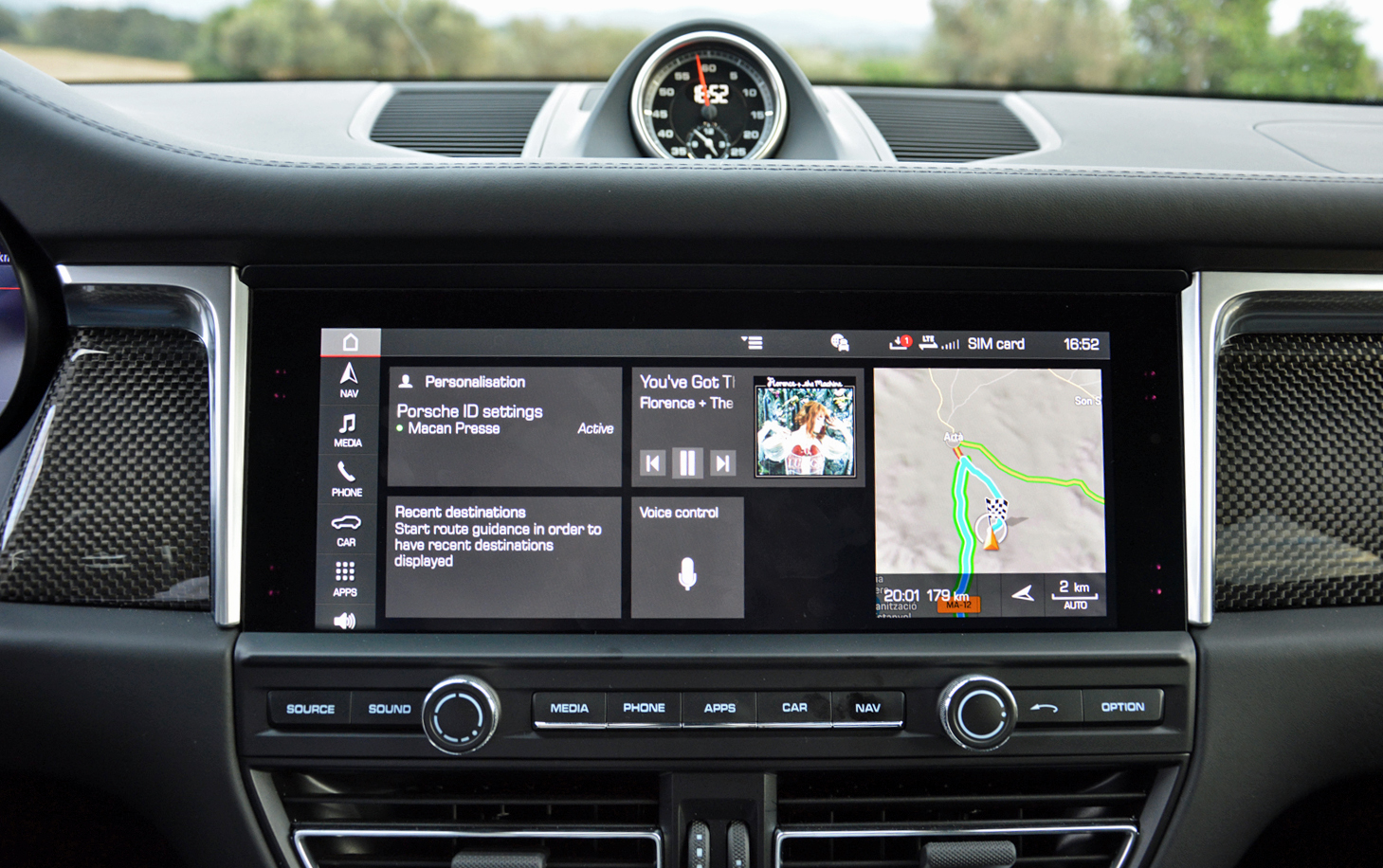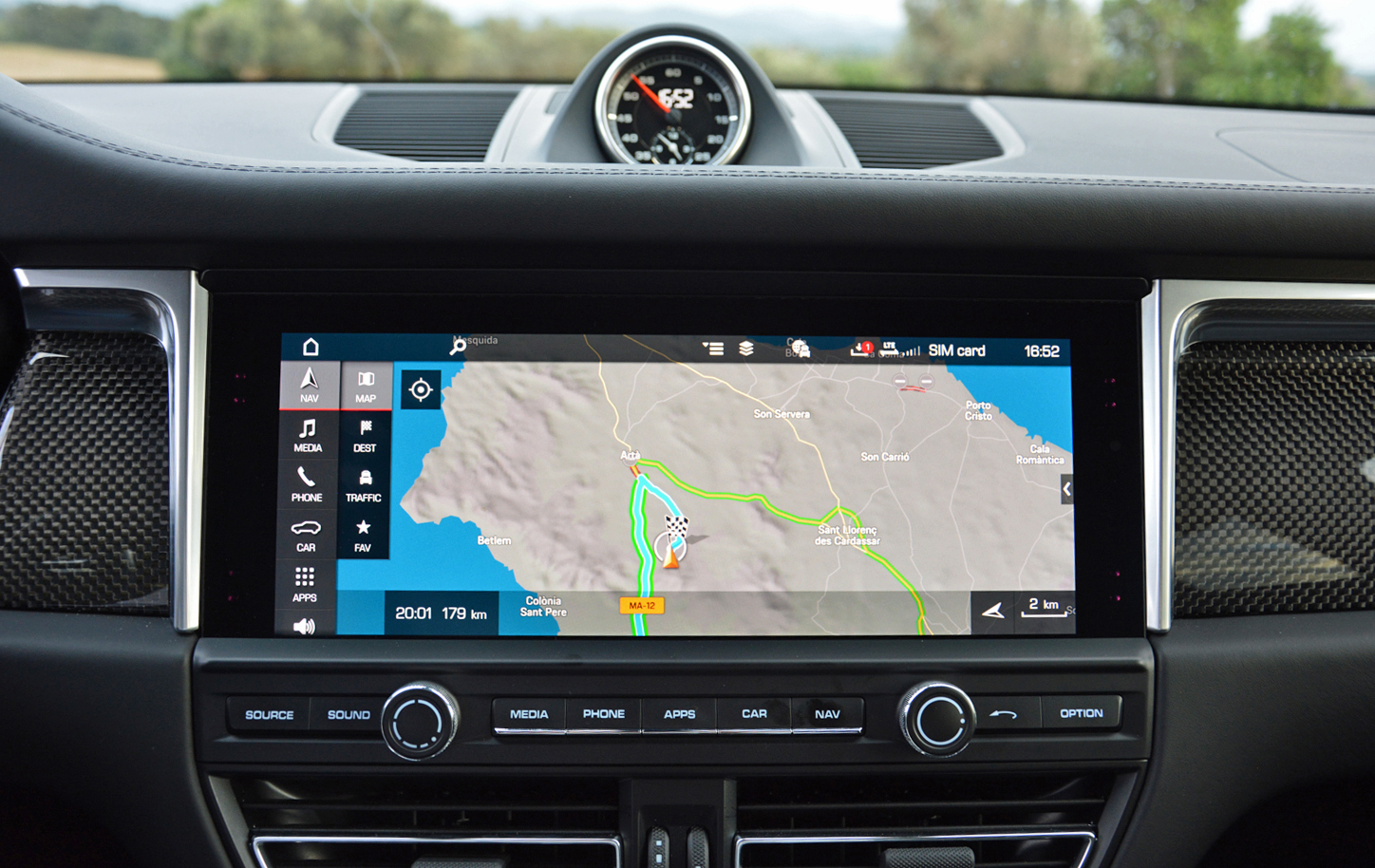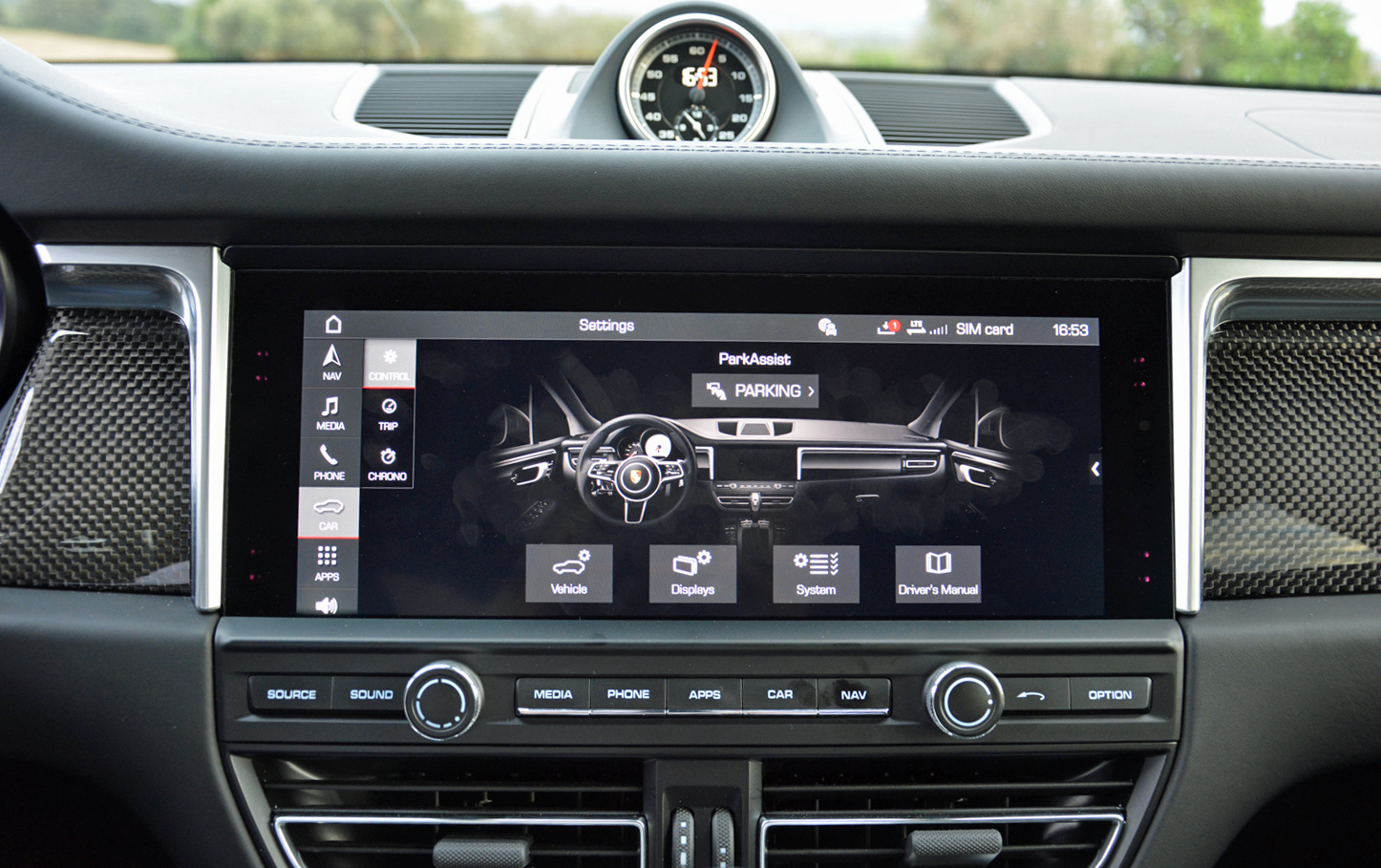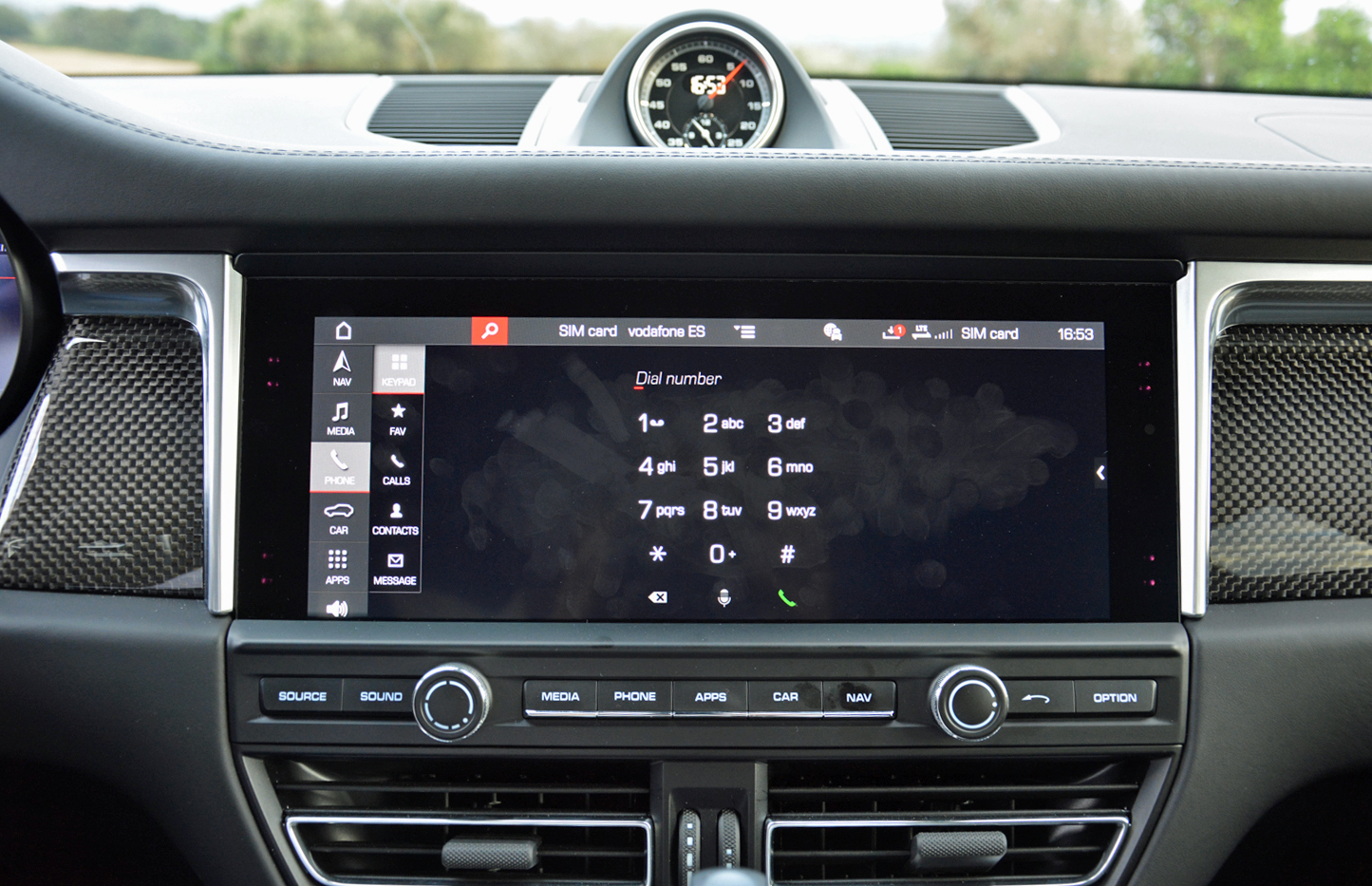“The Porsche Macan is more expensive than its rivals, but buyers get what they pay for.”
- Superb chassis
- Punchy V6 in the Macan S
- Just the right amount of tech
- Upmarket interior
- Limited practicality
- More expensive than its rivals
- No Android Auto… yet
Let’s set the time machine back to 1998.
Everyone was worried about Y2K, Twitter didn’t exist yet, and the idea of putting a Porsche emblem on an SUV was completely, utterly absurd. It was like asking Land Rover to develop a low-slung coupe aimed at the 911. Well, times change, markets evolve, and in 2018 the Macan stands proud as Porsche’s best-seller. The segment it competes in is getting crowded, so Porsche updated its entry-level model with subtle design tweaks, upgraded engines, and new tech features to keep it fresh.
The base Macan starts at $49,900 before Porsche factors in a mandatory $1,050 destination charge. It’s the company’s most affordable model, but it comes well equipped with LED lighting, touchscreen-based navigation, parking sensors on both ends, and Alcantara upholstery in the middle of the seats. The Macan S carries a base price of $58,600 before that same destination charge enters the equation. It notably benefits from a more powerful V6 engine and correspondingly bigger brakes, among other performance-oriented upgrades.

Spot the seven differences
We’ll forgive you if you wondered whether we used the wrong photos to illustrate this story. The 2019 Macan looks a lot like the outgoing model. It’s subtly nip-and-tucked, not entirely new, and the visual updates are largely evolutionary, which is what Porsche buyers demand and expect when a car goes in for a mid-cycle overhaul. Look closely and you’ll notice new-look trim on the front bumper that widens the stance, redesigned LED headlights, and reshaped taillights connected by a three-dimensional LED light bar. The panel is a styling cue that has quickly spread across the entire Porsche lineup. The Cayenne, the Panamera, and the 718 models all wear it, as does the all-new 911 unveiled at the 2018 Los Angeles Auto Show. In other words, the visual changes bring the Macan in line with its stablemates without breaking new ground.
The cabin’s performance-flavored layout hasn’t changed, and it’s as luxurious as ever, but it has gotten smarter.
While we wouldn’t call its roof line coupe-like, the Macan boasts a faster, sportier slope than may of its rivals. The trade-off is that the sheet metal fights for space with the rear occupants’ head. Smaller passengers will sign a cease-fire after finding a common ground, but passengers over the six-foot mark will have a difficult time sitting up straight in the back of the Macan.
The cabin’s performance-flavored layout hasn’t changed, and it’s as luxurious as ever, but it has gotten smarter. Porsche embedded a new version of its Communication Management infotainment system into the dashboard, which we’ll get to in a minute, and added what it calls a GT Sport steering wheel to the list of extra-cost options. It’s a thick-rimmed, three-spoke unit lifted straight out of the 911’s parts bin. The new infotainment system reduces the number of buttons on the dashboard, and it required Porsche to design horizontal air vents. The changes are, again, subtle and evolutionary but they’re meaningful.
The Macan offers 17.7 cubic feet of trunk space with five adults on board, which is on the low side for the segment. Folding down the rear seats yields 53 cubes.
Better where it counts
Bigger is indeed better when it comes to infotainment technology. Every Macan now comes with a 10.9-inch screen that replaces the 7.2-inch unit in the outgoing model. It displays the latest generation of the Porsche Communication Management (PCM) infotainment system. The software contains a tremendous amount of information, putting it on paper would create a book thicker than the P-Zero tires’ sidewall and just as wide as the rims they’re wrapped around, but it’s not as daunting to navigate as it might sound.
Porsche’s connectivity team is working on adding Android Auto compatibility “in the near future.”
The vertical menu on the left side of the screen provides quick, easy access to commonly-used functions like the internet-connected navigation, media and phone options, as well as car settings. The software responds to input almost immediately, it doesn’t stop and think about each command, and the resolution is excellent. The main menu is customizable, too. The Macan is gifted with one of the better infotainment systems in its segment, and we can’t say we’re surprised. We came to the same conclusion after driving the Cayenne and the Panamera.
Porsche’s infotainment system is compatible with Apple CarPlay, though buyers need to pay extra for it. Android users are out of luck; the firm continues to resist Android Auto. There is hope, however. Michaela Ensinger, the electrics and electronics manager for Porsche’s SUV line, told Digital Trends her team is working on integrating Android Auto “in the near future.” Porsche’s engineers have nothing against Android Auto, she explained, but they chose not to offer it because market research showed most buyers owned an Apple device. Cupertino’s hegemony is waning, and there are finally enough Android-wielding Porsche owners to justify adding Android Auto compatibility to the infotainment system. It’s coming sooner rather than later, but Ensinger couldn’t give us a more specific time frame.
In the meantime, motorists can link their smartphone to the Macan via a platform-agnostic app named Porsche Connect. They can open the app to remotely check whether the doors, the tailgate, and the windows are closed, and to lock or unlock the car. The software also provides information like the oil and fuel level plus maintenance data (like when the next service needs to be performed). Finally, it lets owners link the Macan with an Amazon Music account.
The Macan’s instrument cluster honors tradition with an analog tachometer positioned front and center. The speedometer is on the left side, while the real estate on the right side is occupied by a driver-configurable screen. Buttons on the steering wheel let the driver choose between digital gauges that show vital information about what’s going on under the hood (including the oil temperature), navigation directions projected onto a satellite map, and the real-time torque split, which is not as useful in daily driving as the other available options but super-cool to look at.
Porsche isn’t a leader in the field of autonomy, it’s more focused on building an engaging car than on creating one that lets the driver zone out, but it nonetheless offers the Macan with adaptive cruise control – which works as advertised – and traffic jam assist technology, among other driving aids.

Mallorca Express
The cheapest, most basic Macan comes with a turbocharged, 2.0-liter four-cylinder engine that makes 248 horsepower and 273 pound-feet of torque. The entry-level model is largely symbolic. Porsche told Digital Trends the V6-powered Macan S represents a significant chunk of sales in the United States.
The V6-powered Macan S goes fast where most other SUVs would content themselves with simply picking up the pace.
In this case, the S designation denotes the presence of a turbocharged, 3.0-liter V6 engine tuned to deliver 348 horsepower between 5,400 and 6,400 rpm and 354 pound-feet of torque over a broad range that stretches from 1,340 to 4,800 rpm.
Both versions come with a seven-speed, dual-clutch automatic transmission and an all-wheel drive system that sends 80 percent of the engine’s torque to the rear wheels under normal driving conditions. The split is variable, so the front wheels can receive more than 20 percent of the torque if the all-wheel drive system detects the rear axle has lost traction. Two-wheel drive isn’t available.
We spent most of our time behind the wheel of the Macan S. It has six cylinders, three liters, 354 horsepower, seven speeds, and four-wheel drive. It’s easy to get caught up in numbers when you’re talking about a Porsche, and we could continue by listing the 5.1-second zero-to-60-mph time, but what do they add up to in real life? The simple answer is that they allow the Macan to go fast where most other SUVs would content themselves with simply picking up the pace a little bit.

In cities and villages, we kept the drive mode selector – the race car-inspired dial on the steering wheel – set to comfort as we weaved around classic Renault 4s still earning their keep on a daily basis. It’s the softest of the three available profiles. Even in this mode, the Macan’s six delivers punchy, linear acceleration without displaying an abnormal amount of turbo lag. The transmission shifts up smoothly and calmly, the exhaust system keeps its voice down, and the suspension relaxes a little bit. It’s the mode that’s best-suited to cruising on the highway, too. Set the adaptive cruise control, sit back, and bask in an interior made with high-quality materials.
The fun really begins in Sport or, better yet, Sport Plus. Both are just a click of the dial and a winding road away. Our test took place in Mallorca, an island in the Mediterranean with superb roads that are invaded by cyclists like ants on a piece of steak that fell off the grill. On a Saturday afternoon, it’s a better place to test Volvo’s cyclist-detection system than to explore the intricacies of Porsche’s chassis tuning. But, eight hours of sleep be damned, the roads were ours at the break of dawn on the following day.
All aboard the Mallorca Express.
Sport Plus brings out the best of the Macan. The exhaust emits a more menacing growl, the transmission holds gears longer, the suspension tenses up (our tester came with the optional air setup), and the throttle response becomes sharper. Set up this way, the Macan eagerly takes a corner with a high degree of sure-footedness not normally associated with an SUV. It’s not playful in the way a 718 Boxster is. It’s more of a sharp, precision-led instrument that inspires confidence. And, it doesn’t feel as top-heavy as you might expect it to.
The crisp steering makes it easy to place the front wheels where you want them. If it were us tuning it, and Porsche allowed us to nit-pick, we’d dial more weight into the system. But, honing the steering is one of the most difficult parts of developing a modern car, and the Macan mostly gets it right in spite of its size and weight. The brakes are powerful, and the pedal feels sports car-like; Porsche’s decades-long expertise in building engaging machines shines when you ask the Macan to hustle.
You would rightfully expect a car that tilts towards the performance side of the scale to deliver a spine-breaking ride, but it’s not the case. The Macan isn’t the most comfortable car in its segment, and the spread between comfort and performance isn’t as large as in, say, an Audi SQ5, but it’s reasonably compliant and quiet when it needs to be.
Our two-day drive behind the wheel was too short to measure real-world fuel economy. And, because the Macan has been mechanically updated for the 2019 model year, we can’t provide official gas mileage figures from the Environmental Protection Agency (EPA) yet.
Who else is in this SUV-a-thon?
Porsche dropped the Macan into one of the most competitive segments of the market. Motorists are buying luxury SUVs faster than car companies can build them, and the roster of models challenging the Macan grows annually. As of 2018, the list includes:
- Audi Q5 ($42,950) The Q5 stands out by offering a surprisingly large spread between comfort and sport. The 349-horsepower SQ5 holds its own on a twisty road, but it puts a greater emphasis on technology and comfort than on all-out dynamism.
- BMW X3 ($41,000) The X3 stands out as one of the most spacious models in the category. The current-generation model handles better than its predecessors, but it’s not as nice inside as the Macan.
- Jaguar F-Pace ($44,600) The F-Pace joins the Macan at the sporty end of the compact luxury SUV segment. It’s not quite as driver-focused as its German rival, and its interior feels less upmarket, but it offers nearly twice as much cargo space (33 cubic feet) as the Macan. It’s also one of the most efficient models in its competitive set when equipped with Jaguar’s turbodiesel four-cylinder engine.
- Mercedes-AMG GLC ($40,700) The GLC shows what Mercedes-Benz is capable when it’s at the top of its form. It shines with a ride that’s quieter and smoother than the Macan’s, and it’s offered as a stylish, Coupe-badged model with a fastback-like roof line, but neither body style reaches the Macan’s level of athleticism. The AMG-built GLC 63, with its mighty, twin-turbocharged V8, plays in a different league.
Peace of mind
Like every 2019 Porsche, the Macan is covered by a four-year, 50,000-mile warranty. The company also includes a 12-year warranty that covers rust holes in the body shell. The list of standard features includes dual front, front side, and curtain airbags. Buyers can add many optional extras like traffic jam assist (which is made possible by more powerful sensors and image processing technology), lane-keeping and lane-changing assist, and a surround-view camera.
How DT would configure this car
We can’t say how we would configure the 2019 Macan because Porsche hasn’t released a full list of standard and optional features yet. One option we’d happily pay extra for without thinking twice is the heated windshield. It would allow us to throw out the ice scraper and never, ever look back.
Conclusion
The 2019 Macan is a Porsche through and through. It’s a delight to drive, we consider it one of the best-handling SUVs on the market, and in V6-powered S form it’s seriously quick whether you’re pelting it down a straight line or tossing it into a corner. All of the tech features buyers expect to find in a luxury car are accounted for but they’re not forced on the driver. They lurk in the background until they’re needed.
Putting an SUV with a dose of Porsche-ness in your garage doesn’t come cheap, though buyers get the performance and luxury they pay for. But while the Macan is relatively comfortable as a daily driver, buyers who need practicality (notably the ability to regularly carry four adults or a trunk full of gear) will need to sacrifice handling and look at a competitor; the Jaguar F-Pace, for example.














